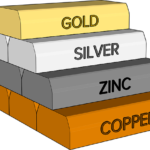K9 Gold Corp. (OTCQB: WDFCF) (TSXV: KNC) (FSE: 5GP) has explored less than 5% of its vast Stony Lake Project, but already the company is discovering its property has real promise. K9 Gold’s property is surrounded by a host of other successful gold properties, including Sokoman Minerals, New Found Gold, and Marathon Gold, and its latest drilling results are revealing several direct similarities to Marathon Gold’s impressive Valentine Lake Project. This week, K9 Gold announced highly significant results from its 2021 drilling program and more specifically, results from drill hole JP21-012 in the Jumper’s Pond area, an area that has been deemed a high-priority drill target by the company.
What those results suggest has the company’s Chief Geologist, Chris M. Healey, P.Geo, extremely confident about the future of the entire project which is nestled in one of the top mining jurisdictions in the entire world—the Exploits Subzone Gold Belt in central Newfoundland.
Results for drill hole JP21-012 found that there were significant grades of gold over substantially wider zones of gold mineralization. What this means for the company and its shareholders is that with substantial widths of gold mineralization, comes the potential to develop a substantial tonnage of mineralized material. According to the company, JP21-012 intersected seven intervals of gold mineralization with six of the seven zones occurring over a core interval of 134 meters or about 440 feet.
K9 Gold noted that the results show the gold mineralization occurs in a steeply dipping structural zone and includes 2.58 g/t Au over a 3.1-meter core interval with a maximum grade of 4.34 g/t Au over a one-meter core interval.
K9 Gold’s chief geologist says these wider zones of gold mineralization compare favorably with Marathon Gold’s Valentine Lake Gold Project and other mines around the world. Additionally, K9 Gold’s results from hole JP21-012 suggest the grades of gold the company has encountered is comparable to those Marathon Gold is reporting in their “reserves.” With a high standard of accuracy, Marathon Gold, a company on the precipice of establishing the largest gold mine in Atlantic Canada to date, states an average grade of 1.36 g/t Au in its reserves.
The gold mineralization being identified in the latest results is in brecciated and shear zones within intermediate volcanic flows of the Lawrenceton Formation. Given both K9 Gold (Stony Lake) and Marathon Gold (Valentine Lake) lie within the Exploits Subzone Gold District, along the Cape Ray/Valentine Lake structural trend, it should come as no surprise that the two gold projects are beginning to reveal real similarities to one another.
Of course, this has K9 Gold’s CEO and its shareholders eagerly awaiting the gold analyses from 6 additional drill holes that were completed along strike of the aforementioned mineralized intervals. Additional highlights from K9 Gold’s results from hole JP21-012 included:
(i) The mineralization is hosted in mafic dykes and variably altered mafic volcanic of the Lawrenceton volcanics.
(ii) The mineralized intervals are characterized by quartz veins, quartz stockworks associated with quartz-pyrite-arsenopyrite-chalcopyrite mineral association. Pyrite-arsenopyrite concentrations are variable and range up to 10% pyrite and 2% arsenopyrite over restricted core intervals. Chalcopyrite is a minor constituent.
(iii) The mineralization is characterized by silicification, carbonate, chlorite, sericite alteration.
(iv) The mineralized intervals exhibit a strong spatial association with an estimated 100 meter wide, near vertical dipping positive chargeability anomaly that can be traced for a horizontal distance of 3,000 meters or almost 2 miles in a northeast-southwest direction.
(v) The mineralization intersected in JP21-012 correlates with several of the mineralized zones intersected in JP21-008.
In its Phase 1 drilling program, the company completed 6,865 meters of diamond drilling on a total of 24 drill holes—18 of which were drilled in the Jumper’s Pond area on the Stony Lake property.
Earlier results from 3 of the initial 17 drill core samples were so highly encouraging that K9 Gold began and completed a detailed follow-up drilling in the vicinity of JP21-012, with 7 additional, tightly spaced holes (JP021-013, 019, 020, 021, 022, 023 and 024). These 7 additional holes were drilled from the same drill pad, as well as two more holes (JP21-014 and JP21-015) which were collared approximately 170 meters to the west. These holes were designed to test an interpreted ENE-trending shear zone at a horizontal spacing of 10 to 40 meters, and a vertical spacing of 30 to 40 meters.
Needless to say, the company’s 2021 exploration program at its Stony Lake Project is proving to be a successful inaugural exploration and drilling season, and it remains quite intriguing as we await results from the remaining drill core samples. K9 Gold has already received approval from the Newfoundland Government Mineral Lands Division for an additional 25 drill holes to cover 5,000 more meters in the high target area of Jumper’s Pond. The company’s chief geologist anticipates that tighter spaced drilling will increase the probability of finding higher grades, which should further add to the excitement being generated around K9 Gold’s property in the Exploits Subzone Gold Belt in central Newfoundland.
To learn more about K9 Gold Corp., visit https://www.k9goldcorp.com or call toll free (833) 434-GOLD (4653).
About K9 Gold Corp. K9 Gold Corp. is a mineral exploration company headquartered in Vancouver, British Columbia, Canada, and currently exploring for gold on its Stony Lake Project in central Newfoundland’s Exploits Subzone Gold Belt.
Read our Disclaimer and Disclosure for this company at: https://stockmarketmediagroup.com/disclaimer/



